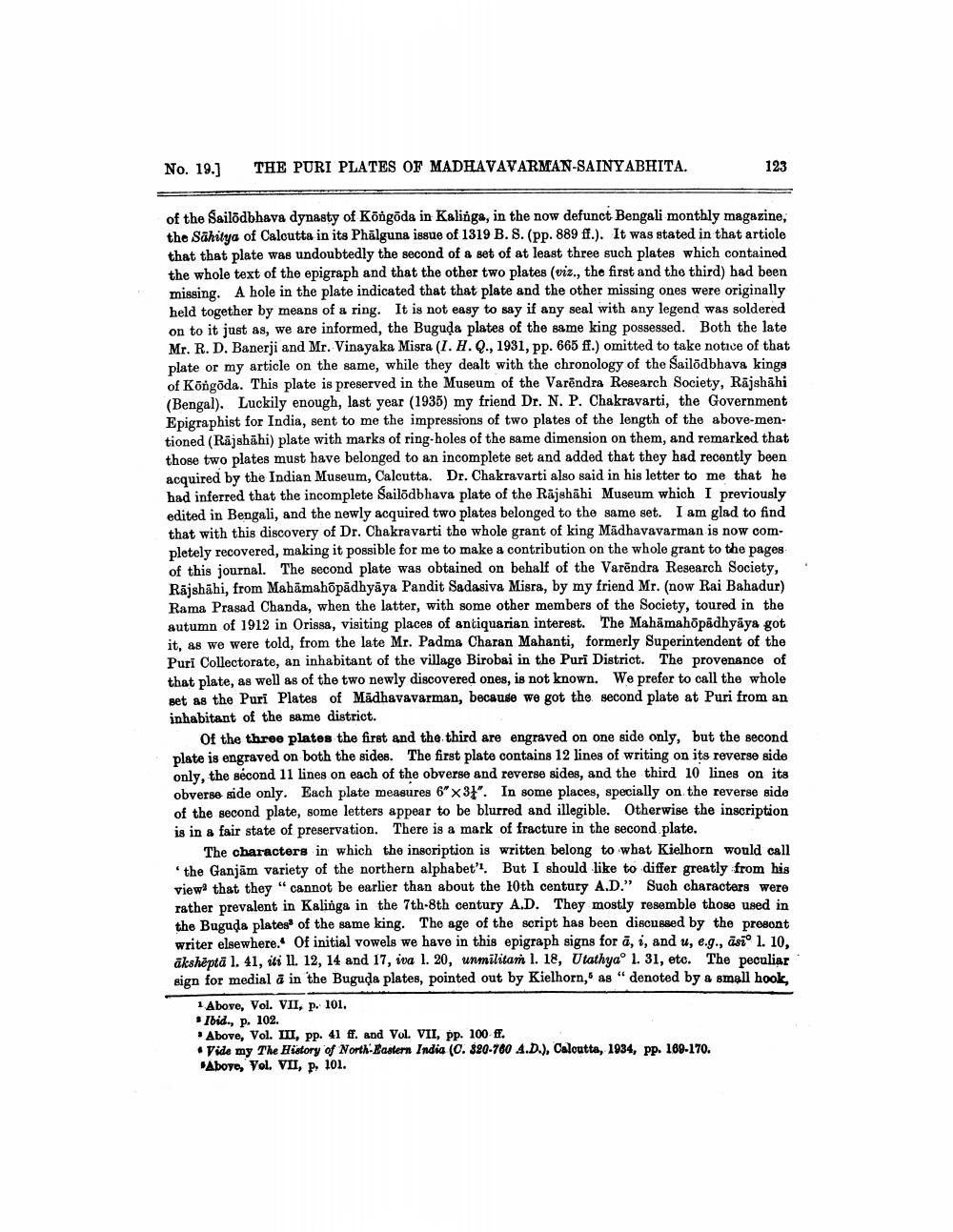________________
No. 19.]
THE PURI PLATES OF MADHAVAVARMAN-SAINYABHITA.
123
of the Sailodbhava dynasty of Köngöda in Kalinga, in the now defunct Bengali monthly magazine, the Sahitya of Calcutta in its Phälguna issue of 1319 B. 8. (pp. 889 ff.). It was stated in that article that that plate was undoubtedly the second of a set of at least three such plates which contained the whole text of the epigraph and that the other two plates (viz., the first and the third) had been missing. A hole in the plate indicated that that plate and the other missing ones were originally held together by means of a ring. It is not easy to say if any seal with any legend was soldered on to it just as, we are informed, the Buguda plates of the same king possessed. Both the late Mr. R. D. Banerji and Mr. Vinayaka Misra (I. H.Q., 1931, pp. 665 ff.) omitted to take notice of that plate or my article on the same, while they dealt with the chronology of the Sailödbhava kings of Köngöda. This plate is preserved in the Museum of the Varēndra Research Society, Rājshāhi (Bengal). Luckily enough, last year (1935) my friend Dr. N. P. Chakravarti, the Government Epigraphist for India, sent to me the impressions of two plates of the length of the above-mentioned (Rājshāhi) plate with marks of ring-holes of the same dimension on them, and remarked that those two plates must have belonged to an incomplete set and added that they had recently been acquired by the Indian Museum, Calcutta. Dr. Chakravarti also said in his letter to me that he had inferred that the incomplete Sailodbhava plate of the Rājshāhi Museum which I previously edited in Bengali, and the newly acquired two plates belonged to the same set. I am glad to find that with this discovery of Dr. Chakravarti the whole grant of king Mädhavavarman is now completely recovered, making it possible for me to make a contribution on the whole grant to the pages of this journal. The second plate was obtained on behalf of the Varendra Research Society, Rājshāhi, from Mahämahopädhyāya Pandit Sadasiva Misra, by my friend Mr. (now Rai Bahadur) Rama Prasad Chanda, when the latter, with some other members of the Society, toured in the autumn of 1912 in Orissa, visiting places of antiquarian interest. The Mahāmahõpādhyāya got it, as we were told, from the late Mr. Padma Charan Mahanti, formerly Superintendent of the Puri Collectorate, an inhabitant of the village Birobai in the Puri District. The provenance of that plate, as well as of the two newly discovered ones, is not known. We prefer to call the whole set as the Puri Plates of Madhavavarman, because we got the second plate at Puri from an inhabitant of the same district.
Of the three plates the first and the third are engraved on one side only, but the second plate is engraved on both the sides. The first plate contains 12 lines of writing on its reverse side only, the second 11 lines on each of the obverse and reverse sides, and the third 10 lines on its obverse side only. Each plate measures 6' 31'. In some places, specially on the reverse side of the second plate, some letters appear to be blurred and illegible. Otherwise the inscription is in a fair state of preservation. There is a mark of fracture in the second plate.
The characters in which the inscription is written belong to what Kielhorn would call the Ganjām variety of the northern alphabet. But I should like to differ greatly from his view that they " cannot be earlier than about the 10th century A.D." Such characters were rather prevalent in Kalinga in the 7th-8th century A.D. They mostly resemble those used in the Buguda plates of the same king. The age of the script has been discussed by the presont writer elsewhere. Of initial vowels we have in this epigraph signs for a, i, and u, e.g., asio 1. 10, ākshēptā 1. 41, iti 11. 12, 14 and 17, ia 1. 20, unmilitaṁ 1. 18, Utathyao 1. 31, etc. The peculiar sign for medial a in the Buguda plates, pointed out by Kielhorn, as " denoted by a small hook,
1 Above, Vol. VII, p. 101. # Ibid., p. 102.
Above, Vol. III, pp. 41 ff. and Vol. VII, pp. 100 ff. • Vide my The History of North-Eastern India (C. $20-780 A.D.), Calcutta, 1934, pp. 168-170.
Above, Vol. VII, p. 101.




